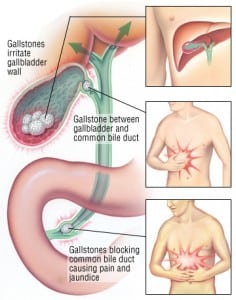What are Gallstones?
The gallbladder is a small sac found just under the liver. It stores bile made by the liver. Bile helps you digest fats. Bile moves from the gallbladder to the small intestine through tubes called the cystic duct and common bile duct.
Gallstones camera.gif are made from cholesterol and other things found in the bile. They can be smaller than a grain of sand or as large as a golf ball.
Most gallstones do not cause problems. But if they block a duct, they usually need treatment.
Gallstones form when cholesterol and other things found in bile make stones. They can also form if the gallbladder does not empty as it should. People who are overweight or who are trying to lose weight quickly are more likely to get gallstones.
Most people who have gallstones do not have symptoms
If you have symptoms, you most likely will have mild pain in the pit of your stomach or in the upper right part camera.gif of your belly. Pain may spread to your right upper back or shoulder blade area. Sometimes the pain is more severe. It may be steady, or it may come and go. Or it may get worse when you eat.
When gallstones keep blocking a bile duct, you may have pain with fever and chills. Or your skin or the whites of your eyes may turn yellow. Call your doctor right away. Having stones in your bile duct increases your chance of having a swollen pancreas camera.gif (pancreatitis). These symptoms may also be a sign of an infected gallbladder.
Treatment for Gallstones
Gallstones are treated only if you have symptoms. Sometimes your doctor may simply want to monitor your condition. If treatment is one, it may include medication, ERCP or surgery.
Medication
Medication can be given by mouth to dissolve some kinds of small stones. But it takes time for the medication to take effect. Stones may return. Medication is most useful for people who cannot have surgery.
ERCP
ERCP (endoscopic retrograde cholangiopancreatography) uses a thin tube with video and x-rays to locate stones and remove them from the common bile duct. ERCP may be done alone or followed by surgery to remove the gallbladder.
Surgery
Surgery is done to remove gallstones and the gallbladder.
- Laparoscopic cholecystectomy uses small incisions to locate and remove the gallbladder.
- Cholecystectomy uses a larger incision to remove the gallbladder.
Preventing Future Symptoms
Once gallstones are dissolved or removed for the ducts, you may be able to prevent them from returning by eating a low-‐fat diet. This means limiting your use of high-‐fat meat and dairy products and vegetable oils. Read food labels to be sure they are low in fat.

